11. Stokes' Theorem
Let \(S\) be a nice surface in \(\mathbf{R}^3\) with a nice properly oriented boundary, \(\partial S\), and let \(\vec{F}\) be a nice vector field on \(S\). Then \[ \iint_S \vec{\nabla}\times\vec{F}\cdot d\vec{S} =\oint_{\partial S} \vec{F}\cdot d\vec{s} \] as seen from the tip of the normal vector to the surface.
Exercises
-
Find \(\displaystyle \iint_S \vec{\nabla}\times\vec{F}\cdot d\vec{S}\) for \(\vec{F}=\langle-2y,2x,xy\rangle\) over the surface of the part of the sphere \(x^2+y^2+z^2=17\) above \(z=1\) oriented upward, using Stokes' Theorem.
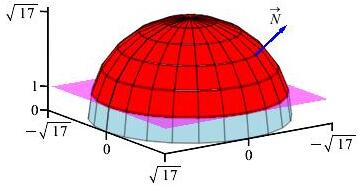
What is the boundary curve?
\(\displaystyle \oint_{\partial S} \vec{F}\cdot d\vec{s}=64\pi\)
By Stokes' Theorem, \(\displaystyle \iint_{S} \vec{\nabla}\times \vec{F}\cdot d\vec{S} =\oint_{\partial S} \vec{F}\cdot d\vec{s}\). So we parameterize the boundary curve at \(z=1\) and evaluate \(\vec{F}\) on that curve. At \(z=1\), \(x^{2}+y^{2}=16\). So \[\begin{aligned} r^{2}&=16\\ r&=4 \end{aligned}\] We can then parametrize our curve as: \[ \vec{r}(\theta) =\langle 4\cos\theta,4\sin\theta,1\rangle \] and compute the velocity: \[ \vec{v}(\theta) =\left\langle -4\sin\theta,4\cos\theta,0\right\rangle \] Since the normal is upward, the boundary must be oriented counterclockwise. This velocity is counterclockwise. Our parametrized vector field, \(\vec{F}=\langle -2y,2x,xy\rangle\), is then: \[ \left.\vec{F}\right|_{\vec{r}(\theta)} =\langle -8\sin\theta,8\cos\theta,16\sin\theta\cos\theta\rangle \] We evaluate the line integral as: \[\begin{aligned} \oint_{\partial S}\vec{F}\cdot d\vec{s} &=\int_{0}^{2\pi} \langle -8\sin\theta,8\sin^{2}\theta,16\sin\theta\cos\theta\rangle \cdot\langle -4\sin\theta,4\cos\theta,0\rangle\,d\theta \\ &=\int_{0}^{2\pi}(32\sin^{2}\theta+32\cos^{2}\theta)\,d\theta =\int_{0}^{2\pi}32\,d\theta= 64\pi \end{aligned}\]
-
Compute \(\displaystyle \iint_S \vec{\nabla}\times\vec{F}\cdot d\vec{S}\) for the vector field \(\vec{F}=\langle-yz,xz,xyz\rangle\) over the quartic surface \(S\) given by \(z=(x^2+y^2)^2\) for \(z \le 16\), oriented down and out.
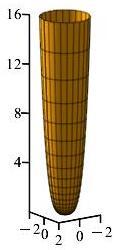
What is the radius of the boundary circle?
\(\displaystyle \iint_{S} \vec{\nabla}\times\vec{F}\cdot d\vec{S} =\oint_{\partial S} \vec{F}\cdot d\vec{s}=-128\pi\)
By Stokes' Theorem, \(\displaystyle \iint_{S} \vec{\nabla}\times \vec{F}\cdot d\vec{S} =\oint_{\partial S} \vec{F}\cdot d\vec{s}\). As a result, we can greatly simplify the integral by integrating over the boundary curve. Using cylindrical coordinates, the surface is: \[ \vec R(r,\theta)=\left\langle r\cos\theta,r\sin\theta,r^4\right\rangle \] On the upper boundary where \(z=16\), we have \[\begin{aligned} (x^2+y^2)^2 &=16\\ x^2+y^2 &=4\\ r &=2 \end{aligned}\] So our circle boundary becomes \[ \vec r(\theta)=\left\langle 2\cos\theta,2\sin\theta,16 \right\rangle \] Using this, we find the velocity: \[ \vec v(\theta)=\left\langle -2\sin\theta,2\cos\theta,0 \right\rangle \] We need the surface oriented down and out. So we must traverse the boundary circle clockwise. This \(\vec v\) is counterclockwise. So we reverse it: \[ \vec v(\theta)=\left\langle 2\sin\theta,-2\cos\theta,0 \right\rangle \] The vector field \(\vec{F}=\langle-yz,xz,xyz\rangle\) becomes: \[ \left.\vec{F}\right|_{\vec r(\theta)} =\langle -32\sin\theta,32\cos\theta,64\sin\theta\cos\theta \rangle \] Their dot product is: \[\begin{aligned} \vec{F}\cdot\vec{v} &=-64\sin^2\theta-64\cos^2\theta\\ &=-64 \end{aligned}\] Finally find the value of the line integral is: \[\begin{aligned} \oint_{\partial S}\vec{F}\cdot d\vec{s} =\int_{0}^{2\pi}-64\,d\theta = -128\pi \end{aligned}\]
-
Compute \(\displaystyle \iint_H \vec{\nabla}\times\vec{F}\cdot d\vec{S}\) for \(F=\left\langle-3y,3x,\sqrt{x^2+y^2}\right\rangle\) over the hyperbolic paraboloid, \(H\), given by \(z=xy\) oriented upward inside the cylinder \(x^2+y^2=9\) by using Stokes' Theorem.
You can rotate the second plot with your mouse.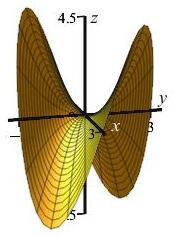
Starting from cylindrical coordinates: \[ \vec R(r,\theta,z)=(r\cos\theta,r\sin\theta,z) \] the surface is \(z=xy=r^2\sin\theta\cos\theta\) which may be parametrized as: \[ \vec R(r,\theta)=(r\cos\theta,r\sin\theta,r^2\sin\theta\cos\theta) \] The boundary is at \(r=3\). So the boundary circle may be parametrized as: \[ \vec r(\theta)=(3\cos\theta,3\sin\theta,9\sin\theta\cos\theta) \]
\(\displaystyle \iint_H \vec{\nabla}\times\vec{F}\cdot d\vec{S} =\oint_{\partial H}\vec{F}\cdot d\vec{s}=54\pi\)
We will use Stokes' Theorem \(\displaystyle \iint\limits_H \vec{\nabla}\times \vec{F}\cdot d\vec{S} =\oint\limits_{\partial H}\vec{F}\cdot d\vec{s}\) to simplify the integral.
Starting from cylindrical coordinates: \[ \vec R(r,\theta,z)=(r\cos\theta,r\sin\theta,z) \] the surface is \(z=xy=r^2\sin\theta\cos\theta\) which may be parametrized as: \[ \vec R(r,\theta)=(r\cos\theta,r\sin\theta,r^2\sin\theta\cos\theta) \] The boundary is at \(r=3\). So the boundary circle may be parametrized as: \[ \vec r(\theta)=(3\cos\theta,3\sin\theta,9\sin\theta\cos\theta) \] The velocity is: \[ \vec v(\theta)=(-3\sin\theta,3\cos\theta,9\cos^{2}\theta-9\sin^{2}\theta) \] On the curve the vector field \(F=\left\langle-3y,3x,\sqrt{x^2+y^2}\right\rangle\) becomes \(\vec{F}=(-9\sin\theta,9\cos\theta,3)\). So the integrand is: \[\begin{aligned} \vec{F}\cdot\vec{v} &=27\sin^{2}\theta+27\cos^{2}\theta+27\cos^{2}\theta-27\sin^{2}\theta \\ &=54\cos^{2}\theta \end{aligned}\] Now the integral can be computed using the identity \(\cos^2\theta=\dfrac{1+\cos2\theta}{2}\): \[\begin{aligned} \oint_{\partial H} \vec{F}\cdot d\vec{s} &=\int_{0}^{2\pi} 54\cos^{2}\theta\,d\theta =\int_{0}^{2\pi} 27\left(1+\cos2\theta\right)\,d\theta \\ &=27\left[\theta+\dfrac{\sin2\theta}{2}\right]_0^{2\pi} =54\pi \end{aligned}\]
-
Verify Stokes' Theorem, \(\displaystyle \iint_C \vec{\nabla}\times\vec{F}\cdot d\vec{S} =\oint_{\partial C} \vec{F}\cdot d\vec{s}\), for the cone \(C\) given by \(z=\sqrt{x^2+y^2}\) for \(z \le 3\) oriented down and out, and the vector field \(\vec{F}=\langle-yz,xz,z^2\rangle\)

-
LHS - Surface Integral: Compute the left side.
Always compute the divergence in rectangular coordinates! When you are ready to do the integral, then you convert the divergence into the coordinates needed for the integral.
\(\displaystyle \iint\limits_{S}\vec{\nabla}\times \vec{F}\cdot d\vec{S}=-54\pi\)
To compute the left side, we first parametrize the cone, \(C\), as: \[ \vec{R}\left( r,\theta \right) =\left( r\cos \theta ,r\sin \theta ,r\right) \] Next we find the normal vector: \[\begin{aligned} \vec{N}&=\vec{e}_{r}\times \vec{e}_{\theta }= \begin{vmatrix} \hat{\imath} & \hat{\jmath} & \hat{k} \\ \cos \theta & \sin \theta & 1 \\ -r\sin \theta & r\cos \theta & 0 \end{vmatrix}\\ &=\left\langle -r\cos \theta,-r\sin \theta,r\right\rangle \end{aligned}\] We reverse \(\vec{N}\) so it points down and out: \[ \vec{N}=\left\langle r\cos\theta,r\sin\theta,-r\right\rangle \] We compute the curl of \(\vec F\): \[ \vec{\nabla}\times \vec{F} =\begin{vmatrix} \hat{\imath} & \hat{\jmath} & \hat{k} \\ \partial x & \partial y & \partial z \\ -yz & xz & z^{2} \end{vmatrix} =\hat{\imath}\left( -x\right) -\hat{\jmath}\left( y\right) +\hat{k}\left( 2z\right) \] On our parametrized surface, this is \[ \vec{\nabla}\times \vec{F} =\left\langle -r\cos \theta,-r\sin \theta,2r\right\rangle \] Its dot product with the normal is: \[ \vec{\nabla}\times \vec{F}\cdot\vec N =-r^2\cos^2\theta-r^2\sin^2\theta-2r^2 =-3r^2 \] Now we compute the integral: \[\begin{aligned} \iint &\vec{\nabla}\times\vec{F}\cdot d\vec{S} =\int_{0}^{2\pi} \int_{0}^{3} \vec{\nabla}\times \vec{F}\cdot\vec N\,dr\,d\theta \\ &=\int_{0}^{2\pi} \int_{0}^{3} (-3r^{2})\,dr\,d\theta =2\pi\left[-r^{3}\right]_{0}^{3}=-54\pi \end{aligned}\]
-
RHS - Line Integral: Compute the right side and verify the theorem.
\(\displaystyle\oint\limits_{\partial S}\vec{F}\cdot d\vec{s}=-54\pi\)
To compute the right side, we parameterize the circle, \(x^{2}+y^{2}=9\), as: \[ \vec{r}\left( \theta \right) =\left( 3\cos \theta,3\sin \theta ,3\right) \] So the velocity vector is \[ \vec{v}(\theta)=\left\langle -3\sin \theta,3\cos \theta,0\right\rangle \] We reverse the velocity vector so it points counterclockwise: \[ \vec{v}(\theta)=\left\langle 3\sin \theta ,-3\cos \theta,0\right\rangle \] Evaluating \(\vec{F}=\left\langle -yz,xz,z^{2}\right\rangle\) along the curve, we get: \[ \left. \vec{F}\right\vert _{\vec{r}\left( \theta \right)} =\left\langle -9\sin \theta,9\cos \theta,9\right\rangle \] So the dot product \(\vec{F}\cdot \vec v\) is: \[ \vec{F}\cdot\vec v=-27\sin ^{2}\theta -27\cos ^{2}\theta +0=-27 \] Finally, we compute the line integral: \[ \oint_{\partial S}\vec{F}\cdot d\vec{s}=\int_{0}^{2\pi}-27\,d\theta =-54\pi \] This matches the left side, so we have verified the theorem!
-
-
Verify Stokes Theorem for the part of the saddle surface (hyperbolic paraboloid), \(z=x^2-y^2\), oriented up, inside the cylinder \(x^2+y^2 = 4\) for the vector field, \(\vec F=\langle-y,x,2z\rangle\).
You can rotate the second plot with your mouse.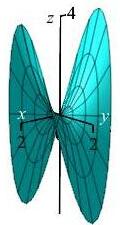
-
LHS - Surface Integral: Compute the left side.
To parametrize the saddle surface, we start with cylindrical coordinates and set \(z=x^2-y^2=r^2(\cos^2\theta-\sin^2\theta)=r^2\cos2\theta\).
\(\displaystyle \iint_{S}\vec{\nabla}\times \vec{F}\cdot d\vec{S}=8\pi\)
To compute the left side, we first parametrize the saddle surface using cylindrical coordinates. Setting \(x=r\cos\theta\) and \(y=r\sin\theta\), we parametrize \(z\) as: \[ z=x^2-y^2=r^2(\cos^2\theta-\sin^2\theta)=r^2\cos2\theta \] From here, we take the cross product of the tangent vectors to obtain the normal vector: \[\begin{aligned} \vec{N}&=\vec{e}_{r}\times \vec{e}_{\theta }= \begin{vmatrix} \hat{\imath} & \hat{\jmath} & \hat{k} \\ \cos \theta & \sin\theta & 2r\cos2\theta \\ -r\sin \theta & r\cos\theta & -2r^2\sin2\theta \end{vmatrix}\\ &=\langle -2r^2(\sin\theta\sin2\theta+\cos\theta\cos2\theta),\\ &\qquad2r^2(\cos\theta\sin2\theta+\sin\theta\cos2\theta),r\rangle \end{aligned}\] Because we want the surface oriented upwards and \(N_z=r>0\), we do not have to change the sign of the normal vector. Next, we compute the curl of the vector field \(\vec F=\langle-y,x,2z\rangle\): \[ \vec{\nabla}\times \vec{F} =\begin{vmatrix} \hat{\imath} & \hat{\jmath} & \hat{k} \\ \partial_x & \partial_y & \partial_z \\ -y & x & 2z \end{vmatrix} =\hat{\imath}(0)-\hat{\jmath}(0)+\hat{k}(2) \] Taking the dot product with the normal gives: \(\vec\nabla\times\vec F\cdot\vec N=2r\). Since we are inside the cylinder \(x^2+y^2=4\) the upper limit on \(r\) is \(2\). Finally, we compute the surface integral: \[\begin{aligned} \iint_S&\vec{\nabla}\times\vec{F}\cdot d\vec{S} =\int_{0}^{2\pi} \int_{0}^{2} \vec{\nabla}\times \vec{F}\cdot\vec N\,dr\,d\theta \\ &=\int_{0}^{2\pi} \int_{0}^{2} (2r)\,dr\,d\theta =2\pi\left[r^{2}\right]_{0}^{2}=8\pi \end{aligned}\]
-
RHS - Line Integral: Compute the right side and verify the theorem.
\(\displaystyle \oint_{\partial S} \vec{F}\cdot d\vec{s}=8\pi\)
First, we parametrize the boundary curve in cylindrical coordinates. Letting \(x=r\cos\theta\) and \(y=r\sin\theta\), we can parametrize \(z\): \[ z=x^2-y^2=r^2(\cos^2\theta-\sin^2\theta)=r^2\cos2\theta \] Our boundary curve where \(r=2\) is then: \[ \vec r(\theta)=\left\langle 2\cos\theta, 2\sin\theta, 4\cos2\theta\right\rangle \] So the velocity vector is: \[ \vec v(\theta)=\left\langle -2\sin\theta, 2\cos\theta, -8\sin2\theta\right\rangle \] Since the orientation is up, we want the velocity to point counterclockwise when looking from above. The velocity already points counterclockwise so we need not reverse it.
We evaluate \(\vec F=\langle -y,x,2z\rangle\) on the surface: \[ \left.\vec F\right |_{\vec r(\theta)} =\langle -2\sin\theta,2\cos\theta,8\cos2\theta \rangle \] The dot product with the velocity is: \[\begin{aligned} \vec F \cdot\vec v &=\langle -2\sin\theta,2\cos\theta,8\cos2\theta \rangle \cdot \left\langle -2\sin\theta, 2\cos\theta,-8\sin2\theta\right\rangle\\ &=4\sin^{2}\theta+4\cos^{2}\theta-64\sin2\theta\cos2\theta =4-32\sin4\theta \end{aligned}\] where we used the identity \(\sin2A=2\sin A\cos A\). Finally, we compute the integral: \[\begin{aligned} \oint\limits_{\partial S}\vec{F}\cdot d\vec{s} &=\int_0^{2\pi} (4-32\sin4\theta)\,d\theta\\ &=\left[4\theta+8\cos4\theta\right]_0^{2\pi}=8\pi \end{aligned}\]
-
-
Verify Stokes' Theorem, \(\displaystyle \iint_S \vec{\nabla}\times\vec{F}\cdot d\vec{S} =\oint_{\partial S} \vec{F}\cdot d\vec{s}\), for the cylinder \(S\) given by \(x^2+y^2=9\) for \(1 \le z \le 2\), oriented outward, and the vector field \(\vec{F}=\langle yz^2,-xz^2,z^3\rangle\).

-
LHS - Surface Integral: Compute the left side.
\(\displaystyle \iint_{S} \vec{\nabla}\times\vec{F}\cdot d\vec{S} =54\pi\)
To compute the left side, we parameterize the cylinder as: \[ \vec{R}\left( \theta ,z\right) =\left\langle 3\cos \theta,3\sin \theta,z\right\rangle \] First we find the tangent vectors and the normal vector: \[\begin{aligned} \vec{N}&=\vec{e}_{\theta}\times \vec{e}_{z}= \begin{vmatrix} \hat{\imath} & \hat{\jmath} & \hat{k} \\ -3\sin \theta & 3\cos \theta & 0 \\ 0 & 0 & 1 \end{vmatrix}\\ &=\left\langle 3\cos \theta,3\sin \theta,0\right\rangle \end{aligned}\] This has the correct orientation. Next we compute the curl of \(\vec F\) and evaluate it on the surface: \[\begin{aligned} \vec{\nabla}\times \left.\vec{F}\right|_{\vec{R}(r,\theta)}&= \begin{vmatrix} \hat{\imath} & \hat{\jmath} & \hat{k} \\ \partial_x & \partial_y & \partial_z \\ yz^{2} & -xz^{2} & z^{3} \end{vmatrix}\\ &=\hat{\imath}\left( 0+2xz\right) -\hat{\jmath}\left( -2yz\right) +\hat{k} \left( -z^{2}-z^{2}\right)\\ &=\left\langle 2xz,2yz,-2z^{2}\right\rangle\\ &=\left\langle 6z\cos \theta,6z\sin \theta,-2z^{2}\right\rangle \end{aligned}\] Now we find the dot product of the curl and the normal: \[\begin{aligned} \vec{\nabla}\times \vec{F}\cdot \vec N &=\left\langle 6z\cos\theta,6z\sin \theta,-2z^{2}\right\rangle \cdot \left\langle 3\cos \theta,3\sin \theta,0\right\rangle \\ &=18z\cos ^{2}\theta +18z\sin ^{2}\theta=18z \end{aligned}\] Finally, we compute the integral: \[\begin{aligned} \iint_{S} \vec{\nabla}\times\vec{F} \cdot d\vec{S} &=\int_{0}^{2\pi }\int_{1}^{2}\left( 18z\right) \,dz\,d\theta\\ &=2\pi \left[ 9z^{2}\right] _{1}^{2}=54\pi \end{aligned}\]
-
RHS - Line Integral: Compute the right side and verify the theorem.
The surface has two boundary curves. You must find the line integral over both and add them.
\(\displaystyle \oint_{\partial S} \vec{F}\cdot d\vec{s}=54\pi\)
To compute the right side, we parameterize the two circles, find their velocity vector, and compute the dot products and integrals. The upper circle can be parameterized as: \[ \vec{r}\left( \theta \right) =\left\langle 3\cos \theta,3\sin \theta, 2\right\rangle \] So the velocity vector is: \[ \vec{v}(\theta)=\left\langle -3\sin \theta,3\cos \theta,0\right\rangle \] By the right hand rule, the upper curve must be traversed clockwise. The \(\vec{v}\) above points counterclockwise, so we have to reverse it: \[ \vec{v}(\theta)=\left\langle 3\sin\theta,-3\cos \theta,0\right\rangle \] From here, we evaluate \(\vec{F}=\left\langle yz^2,-xz^2,z^3\right\rangle\) along the curve: \[ \left. \vec{F}\right\vert _{\vec{r}\left( \theta \right) } =\left\langle 12\sin\theta,-12\cos \theta,8\right\rangle \] Its dot product with the velocity is: \[ \vec{F}\cdot \vec{v} =36\sin^{2}\theta+36\cos^{2}\theta=36 \] Finally, we obtain the integral: \[ \oint\limits_{\text{upper}}\vec{F}\cdot d\vec{s} =\int_{0}^{2\pi}36\,d\theta =72\pi \] The lower circle can be parameterized as \[ \vec{r}(\theta)=\left\langle 3\cos \theta,3\sin \theta, 1\right\rangle \] So the velocity vector is \[ \vec{v}(\theta)=\left\langle -3\sin \theta,3\cos \theta,0\right\rangle \] By the right hand rule, the lower curve must be traversed counterclockwise. The \(\vec{v}\) above points counterclockwise, so we do not need to reverse it. Again, we evaluate \(\vec{F}=\left\langle yz^2,-xz^2,z^3\right\rangle\) along the curve: \[ \left. \vec{F}\right\vert _{\vec{r}\left( \theta \right) } =\left\langle 3\sin\theta,-3\cos \theta,1\right\rangle \] and find its dot product with the velocity: \[ \vec{F}\cdot \vec{v} =-9\sin ^{2}\theta -9\cos ^{2}\theta =-9 \] We obtain the integral: \[ \oint\limits_{\text{lower}} \vec{F}\cdot d\vec{s} =\int_{0}^{2\pi}-9\,d\theta =-18\pi \] Finally, we sum the two line integrals to compute the total right hand side: \[ \oint_{\partial S}\vec{F}\cdot d\vec{s}=72\pi -18\pi=54\pi \] which agrees with the left side.
-
-
Verify Stoke's Theorem on the frustum of the cone \(z=r\) with \(1\le z \le 4\), oriented up and in for the vector field \(\vec G=\langle -yz,xz,z(x^2+y^2)\rangle\).
You can rotate the second plot with your mouse.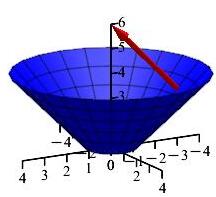
-
LHS - Surface Integral: Compute the left side.
\(\displaystyle \iint_{S} \vec{\nabla}\times\vec{G} \cdot d\vec{S}=126\pi \)
To compute the left side, we must find the normal, take the curl of the vector field and evaluate it on the surface. Then, we take their dot product and integrate.
We parametrize the frustum as: \[ \vec R(r,\theta)=\left\langle r\cos\theta,r\sin\theta,r\right\rangle \] The normal vector is: \[\begin{aligned} \vec{N}&=\vec{e}_{r}\times \vec{e}_{\theta}= \begin{vmatrix} \hat{\imath} & \hat{\jmath} & \hat{k} \\ \cos\theta & \sin\theta & 1 \\ -r\sin \theta & r\cos \theta & 0 \end{vmatrix}\\ &=\left\langle -r\cos \theta,-r\sin \theta,r\right\rangle \end{aligned}\] This normal vector points up and in, as required. We compute the curl of the vector field \(\vec G=\langle -yz,xz,z(x^2+y^2)\rangle\) and then evaluate it on the surface: \[\begin{aligned} \vec{\nabla}\times\vec{G} &=\begin{vmatrix} \hat{\imath} & \hat{\jmath} & \hat{k} \\ \partial_x & \partial_y & \partial_z \\ -yz & xz & z(x^2+y^2) \end{vmatrix}\\ &=\hat{\imath}\left(2yz-x\right)-\hat{\jmath}\left(2xz+y\right)+\hat{k} \left(z+z\right)\\ \vec{\nabla}\times \left.\vec{G}\right|_{\vec{R}(r,\theta)} &=\left\langle 2r^2\sin\theta-r\cos\theta,-2r^2\cos\theta-r\sin\theta, 2r\right\rangle \end{aligned}\] The dot product of the curl and the normal is: \[ \begin{aligned} \vec\nabla\times\vec G \cdot\vec N &=-2r^3\sin\theta\cos\theta+r^2\cos^2\theta\\ &\quad\quad +2r^3\sin\theta\cos\theta+r^2\sin^2\theta+2r^2\\ &=3r^2 \end{aligned} \] Finally, we integrate over the surface: \[ \begin{aligned} \iint_{S} \vec{\nabla}\times\vec{G} \cdot d\vec{S} &=\int_0^{2\pi}\int_1^4 3r^2\,dr\,d\theta\\ &=2\pi\left[r^3\right]_1^4=126\pi \end{aligned} \]
-
RHS - Line Integral: Compute the right side and verify the theorem.
The surface has two boundary curves. You must integrate over both. Since the normal points up and in, in which direction must they be traversed?
\(\displaystyle \oint_{\partial S}\vec{F}\cdot d\vec{s}=126\pi \)
First, we calculate the line integral over the top curve. Since the normal points up and in, we must traverse this curve counterclockwise. We parametrize the upper circle as: \[ \vec r(\theta)=\langle 4\cos\theta,4\sin\theta,4\rangle \] The velocity is: \[ \vec v(\theta)=\langle -4\sin\theta,4\cos\theta,0\rangle \] This velocity is counterclockwise, so we do not need to reverse it. We evaluate the vector field \(\vec G=\langle -yz,xz,z(x^2+y^2)\rangle\) on the boundary: \[ \left.\vec G \right |_{\vec r(\theta)} =\langle -16\sin\theta,16\cos\theta,64\rangle \] Then, we take the dot product of \(\vec G\) and \(\vec v\): \[\begin{aligned} \vec G\cdot \vec v &=\langle -16\sin\theta,16\cos\theta,64\rangle \cdot \langle -4\sin\theta,4\cos\theta,0\rangle\\ &=64\sin^2\theta+64\cos^2\theta=64 \end{aligned}\] Finally, we compute the integral: \[ \oint\limits_{\text{upper}}\vec F\cdot d\vec s =\int_0^{2\pi}64\,d\theta=128\pi \]
We must now do the same on the lower boundary. We parametrize the cirle: \[ \vec r(\theta)=\langle \cos\theta,\sin\theta,1\rangle \] The velocity is: \[ \vec v(\theta)=\langle -\sin\theta,\cos\theta,0\rangle \] This velocity is counterclockwise, but we want it to be clockwise. So, we must reverse the signs: \[ \vec v(\theta)=\langle \sin\theta,-\cos\theta,0\rangle \] We evaluate the vector field \(\vec G=\langle -yz,xz,z(x^2+y^2)\rangle\) on the boundary: \[ \left.\vec G \right |_{\vec r(\theta)} =\langle -\sin\theta,\cos\theta,1 \rangle \] Then, we take the dot product of \(\vec G\) and \(\vec v\): \[\begin{aligned} \vec G\cdot \vec v &=\langle -\sin\theta,\cos\theta,1\rangle \cdot \langle \sin\theta,-\cos\theta,0\rangle\\ &=-\sin^2\theta-\cos^2\theta=-1 \end{aligned}\] Finally, we compute the integral: \[ \oint\limits_{\text{lower}}\vec F\cdot d\vec s =\int_0^{2\pi}-1\,d\theta=-2\pi \] To complete the boundary integral, we add the integrals: \[\begin{aligned} \oint\limits_{\partial S}\vec F\cdot d\vec s &=\oint\limits_{\text{upper}}\vec F\cdot d\vec s +\oint\limits_{\text{lower}}\vec F\cdot d\vec s \\ &=128\pi-2\pi=126\pi \end{aligned}\] Since this is the same answer as part (a), we have verified Stokes' Theorem for this surface.
-
-
Prove Stokes' Theorem for any parametric surface \(\vec{R}(u,v)\) with parameter ranges \(a \lt u \lt b\) and \(c \lt v \lt d\) and a vector field \(\vec{F}=\langle 0,Q(x,y,z),0\rangle\).
LHS: RHS:
You are trying to prove that \[ \iint_S \vec{\nabla}\times\vec{F}\cdot d\vec{S} =\oint_{\partial S} \vec{F}\cdot d\vec{s} \] Start by expanding out the dot product of the curl and the normal vector. What is the parametric chain rule? Is there any way to incorporate that here?
Let \(S=\vec R(u,v)\) be a nice parametric surface with parameter ranges \(a \lt u \lt b\) and \(c \lt v \lt d\) and let \(\vec F\) be a vector field in \(\mathbb{R}^3\) such that \[ \vec F=\langle 0,Q(x,y,z),0 \rangle . \] We must prove that \[ \iint_S \vec\nabla \times \vec F \cdot d\vec S =\oint_{\partial S} \vec F \cdot d\vec s. \] We start by computing the left hand side.
LHS: We first evaluate the curl of \(\vec{F}\): \[\begin{aligned} \vec{\nabla}\times\vec{F} &=\begin{vmatrix} \hat{\imath} & \hat{\jmath} & \hat{k} \\ \partial_x & \partial_y & \partial_z \\ 0 & Q & 0 \end{vmatrix} =\hat{\imath}(-\partial_z Q)-\hat{\jmath}(0)+\hat{k}(\partial_x Q) \\ &=\langle -\partial_z Q,0,\partial_x Q\rangle =\left\langle -\dfrac{\partial Q}{\partial z},0, \dfrac{\partial Q}{\partial x}\right\rangle \end {aligned}\] For our own ease, we now represent the normal vector as Jacobians: \[ \vec{N} =\left\langle\dfrac{\partial(y,z)}{\partial(u,v)}, \dfrac{\partial(z,x)}{\partial(u,v)}, \dfrac{\partial(x,y)}{\partial(u,v)}\right\rangle \] Then we compute the dot product, write out the Jacobians, and rearrange the terms: \[\begin{aligned} \vec{\nabla}\times\vec{F}\cdot \vec{N} &=\left\langle -\dfrac{\partial Q}{\partial z},0, \dfrac{\partial Q}{\partial x}\right\rangle \cdot\left\langle\dfrac{\partial(y,z)}{\partial(u,v)}, \dfrac{\partial(z,x)}{\partial(u,v)}, \dfrac{\partial(x,y)}{\partial(u,v)}\right\rangle \\ &=-\dfrac{\partial Q}{\partial z}\dfrac{\partial(y,z)}{\partial(u,v)} +\dfrac{\partial Q}{\partial x}\dfrac{\partial(x,y)}{\partial(u,v)} \\ &=-\dfrac{\partial Q}{\partial z} \left(\dfrac{\partial y}{\partial u}\dfrac{\partial z}{\partial v} -\dfrac{\partial y}{\partial v}\dfrac{\partial z}{\partial u}\right) +\dfrac{\partial Q}{\partial x} \left(\dfrac{\partial x}{\partial u}\dfrac{\partial y}{\partial v} -\dfrac{\partial x}{\partial v}\dfrac{\partial y}{\partial u}\right) \\ &=\dfrac{\partial y}{\partial u} \left(-\dfrac{\partial Q}{\partial z}\dfrac{\partial z}{\partial v} -\dfrac{\partial Q}{\partial x}\dfrac{\partial x}{\partial v}\right) +\dfrac{\partial y}{\partial v} \left( \dfrac{\partial Q}{\partial z}\dfrac{\partial z}{\partial u} +\dfrac{\partial Q}{\partial x}\dfrac{\partial x}{\partial u}\right) \end{aligned}\] To simplify the above expression, we subtract the expression \(\dfrac{\partial Q}{\partial y}\dfrac{\partial y}{\partial u} \dfrac{\partial y}{\partial v}\) from the first term and add it to the second term. \[\begin{aligned} \vec{\nabla}\times\vec{F}\cdot \vec{N} &=\dfrac{\partial y}{\partial u} \left(-\dfrac{\partial Q}{\partial z}\dfrac{\partial z}{\partial v} -\dfrac{\partial Q}{\partial x}\dfrac{\partial x}{\partial v}\right) +\dfrac{\partial y}{\partial v} \left( \dfrac{\partial Q}{\partial z}\dfrac{\partial z}{\partial u} +\dfrac{\partial Q}{\partial x}\dfrac{\partial x}{\partial u}\right)\\ &\qquad\qquad -\dfrac{\partial Q}{\partial y}\dfrac{\partial y}{\partial u} \dfrac{\partial y}{\partial v} \qquad\qquad\qquad+\dfrac{\partial Q}{\partial y} \dfrac{\partial y}{\partial u}\dfrac{\partial y}{\partial v}\\ &=\dfrac{\partial y}{\partial u} \left(-\dfrac{\partial Q}{\partial z}\dfrac{\partial z}{\partial v} -\dfrac{\partial Q}{\partial x}\dfrac{\partial x}{\partial v} -\dfrac{\partial Q}{\partial y}\dfrac{\partial y}{\partial v}\right)\\ &\qquad\qquad\qquad +\dfrac{\partial y}{\partial v} \left( \dfrac{\partial Q}{\partial z}\dfrac{\partial z}{\partial u} +\dfrac{\partial Q}{\partial x}\dfrac{\partial x}{\partial u} +\dfrac{\partial Q}{\partial y}\dfrac{\partial y}{\partial u}\right) \end{aligned}\] Recognize that this can be condensed using the parametric chain rule: \[ \vec{\nabla}\times\vec{F}\cdot \vec{N} =-\dfrac{\partial y}{\partial u} \dfrac{\partial Q\circ\vec{R}}{\partial v} +\dfrac{\partial y}{\partial v} \dfrac{\partial Q\circ\vec{R}}{\partial u} \] We now add and subtract the term \(\dfrac{\partial^2y}{\partial u\partial v}(Q\circ\vec{R})\) so that each term becomes part of a product rule expansion: \[\begin{aligned} \vec{\nabla}\times\vec{F}\cdot \vec N &=-\dfrac{\partial y}{\partial u}\dfrac{\partial Q\circ\vec{R}}{\partial v} -\dfrac{\partial^2y}{\partial u\partial v}(Q\circ \vec{R}) +\dfrac{\partial y}{\partial v}\dfrac{\partial Q\circ\vec{R}}{\partial u} +\dfrac{\partial^2y}{\partial u\partial v}(Q\circ\vec{R})\\ &=-\dfrac{\partial }{\partial v} \left(\dfrac{\partial y}{\partial u}\,Q\circ\vec{R}\right) +\dfrac{\partial}{\partial u} \left(\dfrac{\partial y}{\partial v}\,Q\circ\vec{R}\right) \end{aligned}\] Now we incorporate this into the integral and split it into two pieces: \[\begin{aligned} \iint_S \vec{\nabla}\times\vec{F}\cdot d\vec{S} &=\int_a^b\int_c^d \left(-\dfrac{\partial }{\partial v} \left(\dfrac{\partial y}{\partial u}\,Q\circ\vec{R}\right) +\dfrac{\partial}{\partial u} \left(\dfrac{\partial y}{\partial v}\,Q\circ\vec{R}\right)\right)\,dv\,du\\ &=-\int_a^b\int_c^d \dfrac{\partial }{\partial v} \left(\dfrac{\partial y}{\partial u}\,Q\circ\vec{R}\right)\,dv\,du +\int_a^b\int_c^d\dfrac{\partial}{\partial u} \left(\dfrac{\partial y}{\partial v}\,Q\circ\vec{R}\right)\,dv\,du \end{aligned}\] We interchange the order of integration in the second integral so that we can apply the Fundamental Theorem of Calculus to both terms: \[\begin{aligned} \iint_S \vec{\nabla}\times\vec{F}\cdot d\vec{S} &=-\int_a^b\int_c^d \dfrac{\partial }{\partial v} \left(\dfrac{\partial y}{\partial u}\,Q\circ\vec{R}\right)\,dv\,du +\int_c^d\int_a^b\dfrac{\partial}{\partial u} \left(\dfrac{\partial y}{\partial v}\,Q\circ\vec{R}\right)\,du\,dv\\ \end{aligned}\] \[\begin{aligned} &=-\int_a^b \left[\dfrac{\partial y}{\partial u}Q\circ\vec{R}\right]_{(u,v)=(u,c)}^{(u,v)=(u,d)}\,du +\int_c^d \left[\dfrac{\partial y}{\partial v}Q\circ\vec{R}\right]_{(u,v)=(a,v)}^{(u,v)=(b,v)}\,dv \end{aligned}\] Finally, we evaluate the functions and reorder the integrals: \[\begin{aligned} \iint_S \vec{\nabla}\times\vec{F}\cdot d\vec{S} &=\int_a^b Q\left(\vec{R}(u,c)\right)\dfrac{\partial y}{\partial u}(u,c)\,du +\int_c^d Q\left(\vec{R}(b,v)\right)\dfrac{\partial y}{\partial v}(b,v)\,dv \\ &-\int_a^b Q\left(\vec{R}(u,d)\right)\dfrac{\partial y}{\partial u}(u,d)\,du -\int_c^d Q\left(\vec{R}(a,v)\right)\dfrac{\partial y}{\partial v}(a,v)\,dv \end{aligned}\] We now want to see that this is the same as the integral on the right.
RHS: To evaluate the right side of the equation, we must evaluate the integral over the closed curve which is the boundary of the surface, which in fact consists of four pieces: two \(u\)-curves and two \(v\)-curves. \[\begin{aligned} \vec{r}_1(u)&=\vec{R}(u,c)=\left(x(u,c),y(u,c),z(u,c)\right) \qquad a \lt u \lt b \\ \vec{r}_2(v)&=\vec{R}(b,v)=\left(x(b,v),y(b,v),z(b,v)\right) \qquad c \lt v \lt d \\ \vec{r}_3(u)&=\vec{R}(u,d)=\left(x(u,d),y(u,d),z(u,d)\right) \qquad a \lt u \lt b \\ \vec{r}_4(v)&=\vec{R}(a,v)=\left(x(a,v),y(a,v),z(a,v)\right) \qquad c \lt v \lt d \end{aligned}\] As in the proof of Green's Theorem, we must travel counterclockwise around the boundary curve but this time as seen from the tip of the normal \(\vec{N}\). If we put our eye at the tip of \(\vec{N}=\vec{e}_u\times\vec{e}_v\), we can rotate our head so that \(\vec{e}_u\) points to the right and \(\vec{e}_v\) points up. Then the \(u\)-coordinate increases from left to right and the \(v\)-coordinate increases from bottom to top. To implement the counterclockwise orientation, we must reverse the orientation of \(\vec{r}_3\) and \(\vec{r}_4\), which we will do by simply putting a minus sign in front of their integrals. So the integral on the right is: \[ \oint_{\partial S} \vec{F}\cdot d\vec{s} =\int_{\vec{r}_1} Q\,dy+\int_{\vec{r}_2} Q\,dy -\int_{\vec{r}_3} Q\,dy-\int_{\vec{r}_4} Q\,dy \] To evaluate these integrals, we must evaluate the function, \(Q\), and the differential, \(dx\), on each curve: \[\begin{aligned} \oint_{\partial S} \vec{F}\cdot d\vec{s} &=\int_a^b Q\left(\vec{R}(u,c)\right)\dfrac{\partial y}{\partial u}(u,c)\,du +\int_c^d Q\left(\vec{R}(b,v)\right)\dfrac{\partial y}{\partial v}(b,v)\,dv \\ &-\int_a^b Q\left(\vec{R}(u,d)\right)\dfrac{\partial y}{\partial u}(u,d)\,du -\int_c^d Q\left(\vec{R}(a,v)\right)\dfrac{\partial y}{\partial v}(a,v)\,dv \end{aligned}\]
Conclusion: This is the same result we found on the left side. So the theorem is proved for the case that \(\vec{F}=\langle 0,Q,0\rangle\)
-
Prove Stokes' Theorem for any parametric surface \(\vec{R}(u,v)\) with parameter ranges \(a \lt u \lt b\) and \(c \lt v \lt d\) and a vector field \(\vec{F}=\langle 0,0,T(x,y,z)\rangle\).
We are trying to prove that \[ \iint_S \vec{\nabla}\times\vec{F}\cdot d\vec{S} =\oint_{\partial S} \vec{F}\cdot d\vec{s} \] Refer to the previous problem as well as the "proof" page in this text. We do not have a solution so that this problem can be assigned as homework.
-
Consider a solid with the shape of an hourglass given in cylindrical coordinates by \[ r=\dfrac{9}{10}|z-3|+\dfrac{1}{5} \] between two disks \(A\) and \(B\) at \(z=1\) and \(z=5\), respectively. Note: We can check both disks have radius \(2\). Consider the vector field \(\vec{F}=\left\langle -yz\sqrt{x^2+y^2},xz\sqrt{x^2+y^2},0\right\rangle\).
-
Compute \(\displaystyle \iint_A \vec{\nabla}\times\vec{F}\cdot d\vec{S}\) for the vector field \(\vec F\) with the disk, \(A\), oriented downward.
\(\displaystyle \iint_A \vec{\nabla}\times\vec{F}\cdot d\vec{S}=-16\pi\)
First, we begin by parameterizing the top disk, \(A\), using a cylindrical coordinate system: \[ \vec R_A(r,\theta)=\langle r\cos\theta,r\sin\theta,1 \rangle \] We use this to find the normal vector: \[\begin{aligned} \vec{N}&=\vec{e}_{r}\times \vec{e}_{\theta}= \begin{vmatrix} \hat{\imath} & \hat{\jmath} & \hat{k} \\ \cos\theta & \sin\theta & 0 \\ -r\sin\theta & r\cos\theta & 0 \end{vmatrix}\\ &=\left\langle 0, 0, r\right\rangle \end{aligned}\] This orientation is up but should be down for the bottom disk. So we reverse it: \[ \vec{N}=\left\langle 0, 0, -r\right\rangle \] Then, we compute the curl of the vector field \(\vec{F} =\left\langle -yz\sqrt{x^2+y^2},xz\sqrt{x^2+y^2},0\right\rangle\): \[\begin{aligned} \vec{\nabla}\times\vec{F} &=\begin{vmatrix} \hat{\imath} & \hat{\jmath} & \hat{k} \\[2pt] \partial_x & \partial_y & \partial_z \\[2pt] -yz\sqrt{x^2+y^2} & xz\sqrt{x^2+y^2} & 0 \end{vmatrix}\\[2pt] &=\hat{\imath}\left(0-x\sqrt{x^2+y^2}\right) -\hat{\jmath}\left(0+y\sqrt{x^2+y^2}\right)+\\ &\qquad\hat{k}\left(\dfrac{zx^2}{\sqrt{x^2+y^2}}+z\sqrt{x^2+y^2}+ \dfrac{zy^2}{\sqrt{x^2+y^2}}+z\sqrt{x^2+y^2} \right)\\ &=\left\langle -x\sqrt{x^2+y^2},-y\sqrt{x^2+y^2},\dfrac{zx^2+zy^2}{\sqrt{x^2+y^2}} +2z\sqrt{x^2+y^2} \right\rangle \\ &=\left\langle -x\sqrt{x^2+y^2},-y\sqrt{x^2+y^2}, z\sqrt{x^2+y^2}+2z\sqrt{x^2+y^2} \right\rangle\\ &=\left\langle -x\sqrt{x^2+y^2},-y\sqrt{x^2+y^2},3z\sqrt{x^2+y^2}\right\rangle \end{aligned}\] and evaluate it on the disk \(A\): \[ \left.\vec{\nabla}\times\vec{F}\right|_{A} =\left\langle -r^2\cos\theta,-r^2\sin\theta,3r\right\rangle \] The dot product of the curl and the normal vector is: \[ \vec\nabla\times\vec{F}\cdot\vec{N}=-3r^2 \] Finally, we evaluate the surface integral over \(A\): \[\begin{aligned} \iint_A \vec{\nabla}\times\vec{F}\cdot d\vec{S} &=\int_0^{2\pi}\int_0^2 -3r^2\,dr\,d\theta \\ &=-2\pi\int_0^2 3r^2\,dr=-16\pi \end{aligned}\] Notice there is no extra factor of \(r\) before the \(dr\,d\theta\) because the Jacobian factor, \(r\), is already included in the \(\vec N\).
Compute \(\displaystyle \iint_B \vec{\nabla}\times\vec{F}\cdot d\vec{S}\) for the vector field \(\vec F\) with the disk, \(B\), oriented upward.
\(\displaystyle \iint_B \vec{\nabla}\times\vec{F}\cdot d\vec{S}=80\pi\)
We compute the surface integral over \(B\) in a very similar manner. First, using \(z=5\), we can parameterize \(B\): \[ \vec B(r,\theta)=\langle r\cos\theta,r\sin\theta,5\rangle \] Note that the normal vector is computed identically, with the only difference being that the orientation is now upward and so the normal does not need to be reversed: \[ \vec N=\langle 0,0,r \rangle \] The curl is computed identically but its value on the surface \(B\) differs because now \(z=5\): \[ \vec{\nabla}\times\vec{F} =\left\langle -x\sqrt{x^2+y^2},-y\sqrt{x^2+y^2},3z\sqrt{x^2+y^2}\right\rangle \] \[ \vec{\nabla}\times \left.\vec{F}\right|_{B} =\left\langle -r^2\cos\theta,-r^2\sin\theta,15r\right\rangle \] Its dot product with the normal is now: \[ \nabla\times\vec{F}\cdot\vec{N}=15r^2 \] Finally, we evaluate the surface integral over \(B\): \[\begin{aligned} \iint_B &\vec{\nabla}\times\vec{F}\cdot d\vec{S} =\int_0^{2\pi}\int_0^2 15r^2\,dr\,d\theta \\ &=2\pi\int_0^2 15r^2\,dr=\left[10\pi r^3\right]_0^2=80\pi \end{aligned}\]
Compute \(\displaystyle \iint_H \vec{\nabla}\times\vec{F}\cdot d\vec{S}\) for the vector field \(\vec F\) over the sides of the hourglass, \(H\), oriented outward.
What does Stokes' Theorem tell us about a line integral over the boundary of this surface? How is this related to the answers in parts (a) and (b)?
You already have all the information you need to solve this problem by using the answers from parts (a) and (b).
\(\displaystyle \iint_S \vec\nabla\times\vec{F}\cdot d\vec{S}=-64\pi\)
Observe that the boundary of the sides of the hourglass consists of two circles:
\(C_1\): with radius \(r=2\) at \(z=1\) traversed counterclockwise, and
\(C_2\): with radius \(r=2\) at \(z=5\) traversed clockwise.Notice that \(C_1\) is also the boundary of disk \(A\) and \(C_2\) is also the boundary of disk \(B\). So we can replace the integrals over \(C_1\) and \(C_2\) by integrals over \(A\) and \(B\). However, \(A\) is oriented downward and so its boundary should be clockwise, whereas \(C_1\) is counterclockwise. So we need a minus before the integral over \(A\). Likewise, \(B\) is oriented upward and so its boundary should be counterclockwise, whereas \(C_2\) is clockwise. So we also need a minus before the integral over \(B\).
So by Stokes' Theorem, three times: \[\begin{aligned} \iint_H \vec\nabla\times\vec{F}\cdot d\vec{S} &=\oint_{C_1}\vec{F}\cdot d\vec{s} +\oint_{C_2}\vec{F}\cdot d\vec{s} \\ &=-\iint_A \vec{\nabla}\times\vec{F}\cdot d\vec{S} -\iint_B \vec{\nabla}\times\vec{F}\cdot d\vec{S}\\ &=16\pi-80\pi=-64\pi \end{aligned}\]
Alternatively, we could have computed the two line integrals, \(\displaystyle \oint_{C_1}\vec{F}\cdot d\vec{s}\) and \(\displaystyle \oint_{C_2}\vec{F}\cdot d\vec{s}\), and used them to find the answers to (a), (b) and (c).
Consider the vector field \(\displaystyle \vec{F}=\langle yz, xz, xy\rangle\). This exercise will show \(\vec F\) is path independent. In other words, the integral \(\displaystyle \int_A^B \vec{F}\cdot d\vec{s}\) is the same for any two curves \(C\) which start at \(A\) and end at \(B\). In particular, the integral is the same for all three of the curves:
• \(C_1\) is the helix \(\vec{r}_1(\theta)=(3\cos\theta, 2+3\sin\theta,\theta)\), for \(0\le\theta\le2\pi\), shown in dashed red.
• \(C_2\) is the sine curve \(\vec{r}_2(\theta)=(3, 2+3\sin\theta,\theta)\), for \(0\le\theta\le2\pi\), shown in solid blue.
• \(C_3\) is the line segment \(\vec{r}_3(\theta)=(3, 2, \theta)\), for \(0\le \theta\le2\pi\), shown in dotted magenta.-
Compute \(\vec\nabla\times\vec F\) for \(\displaystyle \vec{F}=\langle yz, xz, xy\rangle\). Which theorem then guarantees \(\vec F\) is path independent?
\(\vec{\nabla}\times\vec{F}=\vec 0\)
This integral is path independent by Stokes' Theorem.The curl is: \[\begin{aligned} \vec{\nabla}\times\vec{F} &=\begin{vmatrix} \hat{\imath} & \hat{\jmath} & \hat{k} \\ \partial_x & \partial_y & \partial_z \\ yz & xz & xy \end{vmatrix} \\ &=\hat{\imath}(x-x)-\hat{\jmath}(y-y)+\hat{k}(z-z) \\ &=\langle 0,0,0\rangle \end{aligned}\] If we have \(2\) curves which start at \(A\) and end at \(B\), like \(C_1\) and \(C_2\), then going along \(C_1\) and backwards along \(C_2\) is the boundary of a surface between them. So by Stokes' Theorem The integral along \(C_1\) and backwards along \(C_2\) is the integral over the surface between them of the curl of \(\vec F\) which is \(\vec0\). So the two line integrals are equal. It's path independent.
-
Verify the three curves, (i), (ii) and (iii), start and end at the same points \(A\) and \(B\). Then pick one of the three of the curves and compute \(\displaystyle \int_A^B \vec{F}\cdot d\vec{s}\).
Which of the three curves looks easiest?
\(\vec{r}_1(0)=\vec{r}_2(0)=\vec{r}_3(0)= (3,2,0)\)
\(\vec{r}_1(2\pi)=\vec{r}_2(2\pi)=\vec{r}_3(2\pi)= (3,2,2\pi)\)
\(\displaystyle \int_A^B \vec{F}\cdot d\vec{s}=12\pi\)All \(3\) curves start at: \[\begin{aligned} \vec{r}_1(0)&=(3\cos0,2+3\sin0,0) \!\!\!\!\!\! &&= (3,2,0)\\ \vec{r}_2(0)&=(3,2+3\sin0,0) \!\!\!\!\!\! &&= (3,2,0)\\ \vec{r}_3(0)&=(3,2,0) \!\!\!\!\!\! &&= (3,2,0)\\ \end{aligned}\] All \(3\) curves end at: \[\begin{aligned} \vec{r}_1(2\pi)&=(3\cos2\pi,2+3\sin2\pi,2\pi) \!\!\!\!\!\! &&= (3,2,2\pi)\\ \vec{r}_2(2\pi)&=(3,2+3\sin2\pi,2\pi) \!\!\!\!\!\! &&= (3,2,2\pi)\\ \vec{r}_3(2\pi)&=(3,2,2\pi) \!\!\!\!\!\! &&= (3,2,2\pi) \end{aligned}\] So \(A=(3,2,0)\) and \(B=(3,2,2\pi)\). So the integral along the straight line where \(x=3\) and \(y=2\) is: \[ \begin{aligned} \int_A^B \vec{F}\cdot d\vec{s} &= \int_0^{2\pi} \langle yz, xz, xy\rangle \cdot \langle 0, 0, 1\rangle \, d\theta \\ &= \int_0^{2\pi} xy \, d\theta = \int_0^{2\pi} (3)(2) \, d\theta \\ &= 12\pi \end{aligned} \]
tj
-
Find a scalar potential for \(\displaystyle \vec{F}=\langle yz, xz, xy\rangle\). Which theorem then guarantees \(\vec F\) is path independent?
A scalar potential \(f\) must satisfy \(\vec\nabla f=\vec F\). Write out the three equations.
\(f=xyz\)
This integral is path independent by the Fundamantal Theorem of Calculus for Curves.A scalar potential \(f\) must satisfy \(\vec\nabla f=\vec F\) or: \[ \partial_xf=F_1=yz \qquad \partial_yf=F_1=xz \qquad \partial_xf=F_1=xy \] Integrating each says: \[ f = xyz + g(y,z) \qquad f = xyz + h(x,z) \qquad f = xyz + k(xy) \] The common solution is: \[f = xyz\] The Fundamantal Theorem of Calculus for Curves then says this integral is path independent.
tj
-
Use the scalar potential for \(\displaystyle \vec{F}=\langle yz, xz, xy\rangle\) to compute \(\displaystyle \int_A^B \vec{F}\cdot d\vec{s}\) for all three of the curves \(\vec r_1\), \(\vec r_2\) and \(\vec r_3\).
The FTCC says \(\displaystyle \int_A^B\vec\nabla f(\vec{r}_i)\cdot d\vec s =f(B)-F(A)\)
\(\displaystyle \int_A^B\vec F(\vec{r}_i)\cdot d\vec s=12\pi\)
Since \(A=(3,2,0)\) and \(B=(3,2,2\pi)\), using the scalar potential, \(f=xyz\), and the FTCC, all three curves need the same computation: \[\begin{aligned} \int_A^B\vec F(\vec{r}_i)\cdot d\vec s &=\int_A^B\vec\nabla f(\vec{r}_i)\cdot d\vec s =f(B)-F(A) \\ &=(3)(2)(2\pi)-(3)(2)(0)=12\pi \end{aligned}\]
tj
The gas in a tank moves with a velocity vector of \(\vec{V}=\langle 0,-2z,2x\rangle\).
You can rotate the second plot with your mouse.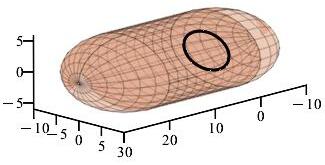
-
Find the circulation of the gas around the closed path \(\vec{r}(\theta)=(2,5\cos\theta,3\sin\theta)\) from \(\theta=0\) to \(2\pi\).
The circulation of a vector \(\vec F\) is \(\displaystyle \oint_{\partial S} \vec F\cdot d\vec s \). What is our vector field, and what is our closed curve?
\(\displaystyle \textrm{Circulation}=\oint_{\partial S} \vec V\cdot d\vec s=30\pi\)
We find the tangent vector of our path: \[\begin{aligned} \vec{r}(\theta)&=(2,5\cos\theta,3\sin\theta)\\ \vec{v}(\theta)&=(0,-5\sin\theta,3\cos\theta) \end{aligned}\] We restrict our fluid velocity \(\vec V\) to the curve \(\vec r(\theta)\): \[ \left.\vec V \right |_{\vec r(\theta)} =\left\langle 0,-6\sin\theta,4 \right\rangle \] We compute their dot product: \[ \vec V\cdot\vec v=30\sin^2(\theta)+12\cos(\theta) \] Finally, we take the line integral using the above as our integrand: \[\begin{aligned} \textrm{Circulation}&=\oint_{\partial S} \vec V\cdot d\vec s =\int_0^{2\pi} 30\sin^2(\theta)+12\cos(\theta)\,d\theta\\ &=\int_0^{2\pi} 30\sin^2(\theta)\,d\theta+ \int_0^{2\pi} 12\cos(\theta)\,d\theta\\ &=\int_0^{2\pi} 30\left(\dfrac{1-\cos2\theta}{2}\right)\,d\theta +\left[\rule{0pt}{10pt}12\sin(\theta)\right]_0^{2\pi} \\ &=15\int_0^{2\pi}1-\cos2\theta\,d\theta +0 \\ &=15\left[\theta-\dfrac{\sin(2\theta)}{2}\right]_0^{2\pi} =30\pi \end{aligned}\]
tj
-
What is the vorticity of the gas?
The vorticity is \(\vec W=\vec\nabla\times\vec V\).
\(\vec W=\langle 2,-2,0\rangle\)
We simply compute the curl of \(\vec V=\langle 0,-2z,2x\rangle\). \[\begin{aligned} \vec W&=\vec{\nabla}\times\vec{V} =\begin{vmatrix} \hat{\imath} & \hat{\jmath} & \hat{k} \\[2pt] \partial_x & \partial_y & \partial_z \\[2pt] 0 & -2z & 2x \end{vmatrix}\\ &=\hat{\imath}(2)-\hat{\jmath}(2)+\hat{k}(0) =\langle 2,-2,0\rangle \end{aligned}\]
tj
-
Recompute the circulation for the curve in part (a), this time using the vorticity calculated in part (b). Notice that the curve is the boundary of the elliptical region: \[ \vec R(t,\theta)=\left\langle 2,5t\cos\theta,3t\sin\theta \right\rangle \] for \(0\le t\le 1\) and \(0\le \theta \le 2\pi\).
\(\displaystyle \textrm{Circulation}=\iint_{S}\vec{W}\cdot d\vec{S}=30\pi \)
We begin by taking the normal vector of the surface: \[\begin{aligned} \vec{N}&=\vec{e}_{t}\times \vec{e}_{\theta}= \begin{vmatrix} \hat{\imath} & \hat{\jmath} & \hat{k} \\ 0 & 5\cos\theta & 3\sin\theta \\ 0 & -5t\sin\theta & 3t\cos\theta \end{vmatrix}\\ &=\left\langle 15t, 0, 0\right\rangle \end{aligned}\] The dot product of vorticity from part (b), \(\vec W=\langle 2,-2,0\rangle\), and the normal is: \[ \vec{W}\cdot\vec{N} =\langle 2,-2,0\rangle\cdot\langle 15t, 0, 0\rangle=30t \] Finally, we compute the surface integral: \[\begin{aligned} \textrm{Circulation} &=\iint_{S}\vec{W}\cdot\vec{N}\,dt\,d\theta =\int_0^{2\pi}\int_0^1 30t\,dt\,d\theta\\ &=60\pi\int_0^1 t\,dt=\left.60\pi\dfrac{t^2}{2}\right|_{0}^{1}=30\pi \end{aligned}\]
tj
Notice the circulation is the same whether computed as the line integral of the velocity or thesurface integral of the vorticity.
Water with velocity vector \(\vec{V} =\left\langle x,0,\dfrac{x^2}{2}\right\rangle\) is flowing down a river.
-
What is the vorticity of the water?
\( \vec W=\left\langle 0,-x,0\right\rangle \)
We can compute the vorticity of the water using the formula: \[ \vec W=\vec\nabla\times\vec{V} \] Since \(\vec V=\left\langle x,0,\dfrac{x^2}{2}\right\rangle\), we can easily take the curl: \[\begin{aligned} \vec{\nabla}\times\vec{V} &=\begin{vmatrix} \hat{\imath} & \hat{\jmath} & \hat{k} \\[2pt] \partial_x & \partial_y & \partial_z \\[2pt] x & 0 & \dfrac{x^2}{2} \end{vmatrix}\\ &=\hat{\imath}(0)-\hat{\jmath}\left(x\right)+\hat{k}(0)\\ &=\left\langle 0,-x,0\right\rangle \end{aligned}\]
-
Use the vorticity to find the circulation of the water around the boundary of the rectangle in the plane of \(y=2\) where \(x\) ranges from \(0\) to \(3\) and \(z\) ranges from \(0\) to \(2\), orientated counterclockwise as seen from the positive \(y\)-axis.
You can rotate the second plot with your mouse.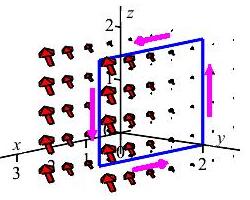
\(\displaystyle \textrm{Circulation}=\iint_{S}\vec{W}\cdot d\vec{S}=-25 \)
Recall the formula for circulation: \[ \textrm{Circulation}=\oint_{C}\vec{V}\cdot d\vec{s} \] Using Stokes' Theorem, we can put this in terms of the curl which we have already calculated: \[\begin{aligned} \textrm{Circulation} &=\iint_{S}\vec\nabla\times\vec{V}\cdot d\vec{S} \\ &=\iint_{S}\vec{W}\cdot d\vec{S} \end{aligned}\]
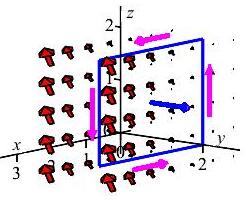
Since \(d\vec{S}=\vec{N}\,dA\), we need to compute the normal vector. We begin by parameterizing our rectangle: \[ \vec R(s,t)=\langle t,2,s\rangle \] Where \(0\le s\le 2\) and \(0\le t\le 3\). Thus, the normal vector is: \[\begin{aligned} \vec{N}&=\vec{e}_{s}\times \vec{e}_{t}= \begin{vmatrix} \hat{\imath} & \hat{\jmath} & \hat{k} \\ 0 & 0 & 1 \\ 1 & 0 & 0 \end{vmatrix}\\ &=\left\langle 0, 1, 0\right\rangle \end{aligned}\] This normal vector is pointing towards positive \(y\), which indicates a counterclockwise rotation. As a result, we do not need to reverse it. The vorticity evaluated on the surface is: \[ \vec W=\left\langle 0,-x,0\right\rangle =\left\langle 0,-t,0\right\rangle \] So the dot product of the vorticity and the normal vector is \(\vec W\cdot\vec N=-t\). Using this, we compute the integral: \[\begin{aligned} \textrm{Circulation}&=\iint_{S}\vec{W}\cdot d\vec{S} =\int_0^2\int_0^3 -t\,dt\,ds\\ &=-2\int_0^3 t\,d =-2\left[\dfrac{t^2}{2}\right]_{0}^{3} =-25 \end{aligned}\] The minus indicates that the fluid is actually rotating clockwise.
tj
Note: In this problem it is easier to compute the circulation from the vorticity for two reasons. First, the curl is simple in this particular problem. Second, the direct line integral requires \(4\) separate integrals.
The magnetic field \(\vec{B}=\langle x^3,y^2z,y^3+yz^2\rangle\) is produced by an the electrical current \(I\) flowing in the positive \(x\) direction through the surface of a disk of radius \(2\) parallel to the \(yz\)-plane with center at \((2,0,0)\). Find \(I\) using:
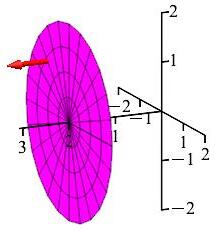
-
the differential version of Ampere's Law.
\(I=3\)
Ampere's Law states that \[ \vec\nabla\times\vec B=4\pi\vec{J} \] where \(\vec B\) is the magnetic field vector and \(\vec J\) is the electric current density vector. By Stokes' Theorem, we also have that \[ I=\iint_S \vec J\cdot d\vec{S} \] Since we know that \(\vec J\) is just \(\dfrac{\vec \nabla\times\vec B}{4\pi}\), we can compute the current by evaluating the following integral: \[ I=\dfrac{1}{4\pi}\iint_S \vec\nabla \times\vec B \cdot d\vec{S} \] First, we parametrize the surface in terms of \(r\) and \(\theta\): \[ \vec R(r,\theta)=\langle 2,r\cos\theta,r\sin\theta \rangle \] Next, we take the normal vector of the surface: \[\begin{aligned} \vec{N}&=\vec{e}_{r}\times \vec{e}_{\theta}= \begin{vmatrix} \hat{\imath} & \hat{\jmath} & \hat{k} \\ 0 & \cos\theta & \sin\theta \\ 0 & -r\sin\theta & r\cos\theta \end{vmatrix}\\ &=\left\langle r, 0, 0\right\rangle \end{aligned}\] Notice \(\vec N\) points in the positive \(x\) direction as required. We then take the curl of \(\vec B\): \[\begin{aligned} \vec{\nabla}\times\vec{B} &=\begin{vmatrix} \quad\hat{\imath} & \hat{\jmath} & \hat{k} \\[2pt] \quad\partial_x & \partial_y & \partial_z \\[2pt] \quad x^3 & y^2z & y^3+yz^2 \end{vmatrix}\\ &=\hat{\imath}(3y^2+z^2-y^2)-\hat{\jmath}(0-0)+\hat{k}(0-0)\\ &=\left\langle 2y^2+z^2,0,0\right\rangle \end{aligned}\] Since \(y=r\cos\theta\) and \(z=r\sin\theta\), we have \[ \vec\nabla\times\vec B =\left\langle 2r^2\cos^2\theta+r^2\sin^2\theta,0,0\right\rangle =\langle r^2(\cos^2\theta+1),0,0 \rangle \] The dot product is: \[ \vec\nabla\times\vec B\cdot\vec N=r^3(\cos^2\theta+1) \] Finally, we compute the surface integral: \[\begin{aligned} I&=\dfrac{1}{4\pi}\iint_S \vec\nabla\times\vec B\cdot d\vec S =\dfrac{1}{4\pi}\int_0^{2\pi}\int_0^2 r^3(\cos^2\theta+1)\,dr\,d\theta \\ &=\dfrac{1}{4\pi}\left( \int_0^2 r^3 \,dr \right) \left( \int_0^{2\pi} \cos^2\theta+1 \,d\theta\right) \\ &=\dfrac{1}{\pi}\int_0^{2\pi} \dfrac{1+\cos2\theta}{2}+1 \,d\theta =\dfrac{1}{\pi}\left[\dfrac{3\theta}{2} +\dfrac{\sin2\theta}{4}\right]_{0}^{2\pi}=\dfrac{3\pi}{\pi}=3 \end{aligned}\]
-
the integral version of Ampere's Law.
\(I=3\)
Ampere's law states that \[ I=\dfrac{1}{4\pi}\oint_{C} \vec{B}\cdot d\vec{s} \] where \(\vec B\) is the magnetic field vector and \(I\) is the current through a closed loop \(C\). We can solve directly, first by parameterizing the boundary of the disk: \[ \vec r(\theta)=\langle 2, 2\cos\theta,2\sin\theta \rangle \] Then, we compute the velocity: \[ \vec v(\theta)=\langle 0, -2\sin\theta,2\cos\theta \rangle \] We must parametrize \(\vec B=\langle x^3,y^2z,y^3+yz^2\rangle\) in terms of this curve: \[\begin{aligned} \left.\vec B\right|_{\vec r(\theta)} &=\langle 8,8\cos^2\theta\sin\theta,8\cos^3\theta+8\cos\theta\sin^2\theta\rangle\\ &=\langle 8,8\cos^2\theta\sin\theta, 8\cos\theta\left(\cos^2\theta+\sin^2\theta\right)\rangle\\ &=\langle 8,8\cos^2\theta\sin\theta,8\cos\theta\rangle \end{aligned}\] The penultimate step involves taking the dot product of \(\left.\vec B\right|_{\vec r(\theta)}\) with \(\vec v\): \[\begin{aligned} \left.\vec B\right|_{\vec r(\theta)}\cdot\vec v &=0-16\cos^2\theta\sin^2\theta+16\cos^2\theta\\ &=16\cos^2\theta\left(1-\sin^2\theta\right)=16\cos^4\theta \end{aligned}\] Finally, we compute the integral: \[\begin{aligned} I&=\dfrac{1}{4\pi}\oint_{C}\vec{B}\cdot d\vec{s} =\dfrac{1}{4\pi}\int_0^{2\pi} 16\cos^4\theta\,d\theta\\ &=\dfrac{1}{4\pi}\int_0^{2\pi}16\left(\dfrac{1+\cos2\theta}{2}\right)^2\,d\theta\\ &=\dfrac{1}{\pi}\int_0^{2\pi}(1+2\cos2\theta+\cos^22\theta)\,d\theta\\ &=\dfrac{1}{\pi}\int_0^{2\pi}1+2\cos2\theta+\dfrac{1+\cos4\theta}{2}\,d\theta\\ &=\dfrac{1}{\pi}\left[\dfrac{3\theta}{2}+\sin{2\theta} +\dfrac{\sin4\theta}{8}\right]_0^{2\pi}=\dfrac{3\pi}{\pi}=3 \end{aligned}\]
×Heading
Placeholder text: Lorem ipsum Lorem ipsum Lorem ipsum Lorem ipsum Lorem ipsum Lorem ipsum Lorem ipsum Lorem ipsum Lorem ipsum Lorem ipsum Lorem ipsum Lorem ipsum Lorem ipsum Lorem ipsum Lorem ipsum Lorem ipsum Lorem ipsum Lorem ipsum Lorem ipsum Lorem ipsum Lorem ipsum Lorem ipsum Lorem ipsum Lorem ipsum Lorem ipsum
-